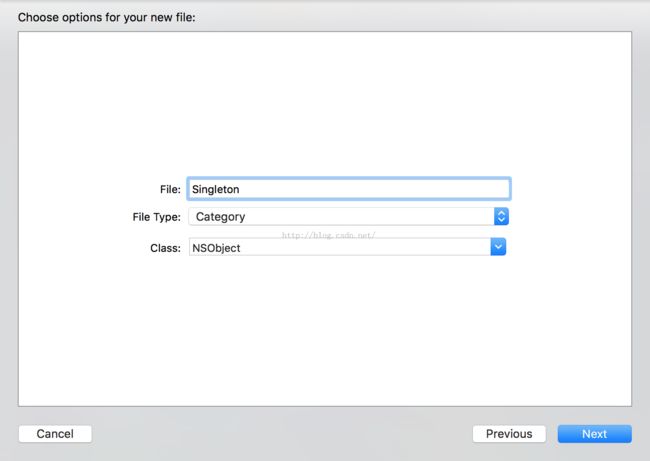iOS开发——单例的实现、使用与架构
单例在我们开发中是最常用的设计模式,在iOS中也是如此。单例可以保证某个类的实例在程序中是唯一的,便于进行资源和数据的共享。使用的设计原则是单一职责原则。我们来看看在iOS中本身自带的类或者方法哪些使用了单例的模式:
(1)UIAccelerometer类和sharedAccelerometer方法,一般如果方法名中有shared这样的词,就可以认为这是一个可以整个应用程序共享的实例变量,一般是使用了单例。
(2)UIApplication类和sharedApplication方法,我们一般使用该方法来创建全局变量。
(3)NSBundle类和mainBundle方法。
(4)NSFileManager类和defaultManager方法。
(5)NSNotificationCenter类和defaultManager方法。其中NSNotificationCenter也实现了观察者模式。
(6)NSUserDefaults类和defaultUser方法。
示例代码上传至:https://github.com/chenyufeng1991/iOS-Singleton 。
【单例实现】
(1)新建一个普通的类,假设名字为Singleton. 在Singleton.h中声明一个类方法,到时候使用该类方法(注意:一定是类方法,而不是实例方法)可以创建该类的唯一的一个实例:
#import <Foundation/Foundation.h> @class Singleton; @interface Singleton : NSObject // "+" 表示类的方法,由类调用 +(Singleton *)sharedInstance; @end
(2)在Singleton.m中需要实现sharedInstance方法和你其他的业务逻辑:
#import "Singleton.h"
// 用static声明一个类的静态实例;
static Singleton *_sharedInstance = nil;
@implementation Singleton
/**
* 1.使用类方法生成这个类唯一的实例;
*/
+(Singleton *)sharedInstance{
if (!_sharedInstance) {
_sharedInstance =[[self alloc]init];
}
return _sharedInstance;
}
@end
注意:一定要声明一个static的静态变量。以后创建类的唯一实例就使用sharedInstance方法,而不是使用alloc ,init.
(3)我们使用一个简单的demo来演示一下单例:
#import "RootVC.h"
#import "Singleton.h"
@interface RootVC ()
@end
@implementation RootVC
- (void)viewDidLoad
{
[super viewDidLoad];
[self testSigleTon];
}
-(void)testSigleTon
{
//单例的结果就是,调用类方法,只返回一个共有的对象
/**
* single和single2是同一个对象;
因为返回的数据是一个静态变量,全局唯一;
*/
Singleton *single = [Singleton sharedInstance];
Singleton *single2 = [Singleton sharedInstance];
if (single == single2) {
NSLog(@"single == single2");
}
NSLog(@"single地址:%@",single);
NSLog(@"single2地址:%@",single2);
}
@end
(4)输出结果如下:
可以看到,两个对象的内存地址是一样的,表示这两个对象其实是同一个对象,单例也就实现了。这是单例最普遍也是最简单的实现方式,在项目中会经常用到,在不涉及多线程的情况下是完全正确的。但是,我们再多想一想,在多线程开发中,这种实现方式是否安全呢?那么应该如何实现。
【单例架构】
在项目开发中,如果我们像上述实现方法一样,在每个类中都使用这样写一个方法来生成单例,会不会显得很麻烦,很冗余。这样重复在每个类中重复写代码不利于开发与架构,那么我们应该使用什么方法来进行代码抽取呢?解决方案就是使用类别(Category)。关于Category类别的简要介绍,请参考《Objective-C——类别(Category)详解》。具体的实现如下:
(1)新建一个Category,作为对NSObject类的扩展。因为NSObject类是大部分iOS类的基类,如果使用Category为NSObject增加额外方法(shareInstance方法),那么所有继承自NSObject的类都可以使用该方法。我们常用的UIViewController和UIView都是从NSObject继承的,这样就会很方便。
需要在NSObject+Singleton.h头文件中对外暴露一个生成实例的方法,供其他类调用。
#import <Foundation/Foundation.h> @interface NSObject (Singleton) // "+" 表示类的方法,由类调用 + (instancetype)sharedInstance; @end
#import "NSObject+Singleton.h"
@implementation NSObject (Singleton)
//使用可变字典存储每个类的单一实例,键为类名,值为该类的对象;
//声明为静态变量,可以保存上次的值;
static NSMutableDictionary *instanceDict;
id instance;
+ (instancetype)sharedInstance {
@synchronized(self)
{
//初始化字典;
if (instanceDict == nil) {
instanceDict = [[NSMutableDictionary alloc] init];
}
//获取类名;
NSString *className = NSStringFromClass([self class]);
if (className) {
//查找字典中该类的对象,使用类名去进行查找,可以确保一个类只被存储一次;
instance = instanceDict[className];
if (instance == nil) {
//该类的对象还没实例化,就进行初始化,并根据键值对的形式存储;
instance = [[self.class alloc] init];
[instanceDict setValue:instance forKey:className];
}else{
//该类对象已经存储在字典中,直接返回instance即可;
}
}else{
//没有获取类名,所以确保sharedInstance是一个类方法,用类进行调用;
}
return instance;
}
}
@end
(4)单例的category已经写完,下面将要进行测试。我这里的测试方法如下:两个界面之间进行跳转并返回,使用相同的代码生成类对象;同时新建一个Person类和StudentModel类来测试,两个类都分别继承自NSObject,里面没有任何实现,只用来创建对象。别忘了导入头文件#import "NSObject+Singleton.h".
第一个界面ViewController.m实现如下:
#import "ViewController.h"
#import "NSObject+Singleton.h"
#import "Person.h"
#import "StudentModel.h"
@interface ViewController ()
@end
@implementation ViewController
- (void)viewDidLoad {
[super viewDidLoad];
}
- (void)viewDidAppear:(BOOL)animated{
[super viewDidAppear:true];
//使用sharedInstance创建类对象;
ViewController *vc1 = [ViewController sharedInstance];
ViewController *vc2 = [ViewController sharedInstance];
NSLog(@"ViewController---vc1地址:%@",vc1);
NSLog(@"ViewController---vc2地址:%@",vc2);
if (vc1 == vc2) {
NSLog(@"ViewController---vc1 == vc2");
}
//循环创建5个Person对象,5个对象都相同;
for (int i = 0; i < 5; i++) {
Person *per1 = [Person sharedInstance];
NSLog(@"ViewController---per1地址:%@",per1);
}
//使用alloc创建对象,每个对象都是不同的;
for (int i = 0; i < 5; i++) {
StudentModel *stud = [[StudentModel alloc] init];
NSLog(@"ViewController---stud地址:%@",stud);
}
}
@end
第二个界面SecondViewController.m实现如下:
#import "SecondViewController.h"
#import "NSObject+Singleton.h"
#import "Person.h"
#import "StudentModel.h"
#import "ViewController.h"
@interface SecondViewController ()
@end
@implementation SecondViewController
/**
* 在另一个界面中做同样的测试;
*/
- (void)viewDidLoad {
[super viewDidLoad];
}
- (void)viewDidAppear:(BOOL)animated{
[super viewDidAppear:animated];
SecondViewController *secondVc1 = [SecondViewController sharedInstance];
SecondViewController *secondVc2 = [SecondViewController sharedInstance];
NSLog(@"SecondViewController---secondVc1地址:%@",secondVc1);
NSLog(@"SecondViewController---secondVc2地址:%@",secondVc2);
if (secondVc1 == secondVc2) {
NSLog(@"SecondViewController---secondVc1 == secondVc2");
}
for (int i = 0; i < 5; i++) {
Person *per1 = [Person sharedInstance];
NSLog(@"SecondViewController---per1地址:%@",per1);
}
for (int i = 0; i < 5; i++) {
StudentModel *stud = [[StudentModel alloc] init];
NSLog(@"SecondViewController---stud地址:%@",stud);
}
}
/**
* 返回上一界面,再次生成对象查看;
*
* @param sender <#sender description#>
*/
- (IBAction)back:(id)sender {
[self dismissViewControllerAnimated:true completion:nil];
}
@end
下面分别是三个步骤打印log:启动第一个界面、跳转到第二个界面、返回第一个界面。
启动第一个界面的输出:
跳转到第二个界面的输出:
再次返回到第一个界面的输出:
总结,通过以上打印输出,使用sharedInstance创建单例后,无论在哪一个界面,每个类的对象是唯一的。而使用alloc创建的对象往往都是不同的。通过以上的设计,就不需要在每一个类中都去实现sharedInstance方法了。
github主页:https://github.com/chenyufeng1991 。欢迎大家访问!
最近极客学院Wiki正在进行IT职业技能图谱的制定,我主要负责iOS方向,大家感兴趣的可以一起参加,有问题或者修改可以直接给我发issues或者pull request。https://github.com/chenyufeng1991/skillmap 。





